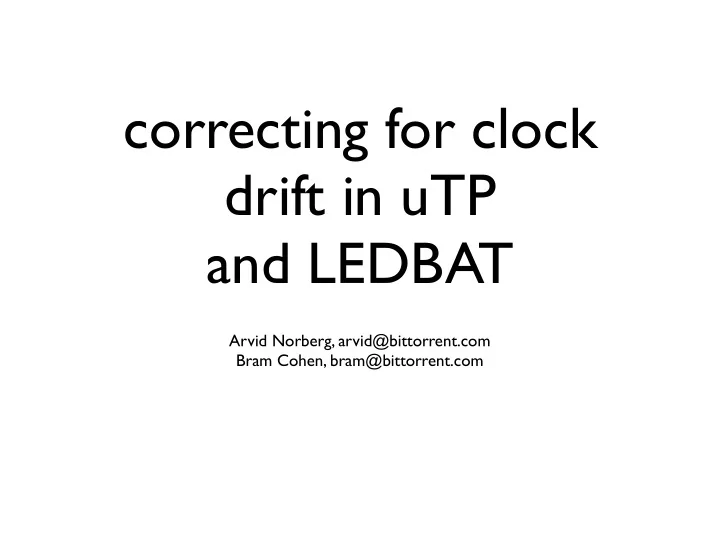

correcting for clock drift in uTP and LEDBAT Arvid Norberg, arvid@bittorrent.com Bram Cohen, bram@bittorrent.com
A B x = now() x diff = now() - x f f i d base_delay = min(base_delay, diff) delay = diff - base_delay cwnd += (target - delay)· gain
• using a base delay of the lowest ever received diff assumes that at least one packet will get through with no buffering delay • only ever adjusting base_delay downwards assumes no clock drift
• One solution to clock drift is to update base_delay periodically with the lowest seen diff in the last period • What should the interval be? • If it’s too short, we’ll set the base delay to a sample that isn’t the true lowest value, and our measurements are unreliable • If it’s too long, we’ll allow a significant drift before adjusting, and our measurements are unreliable
delay_base update interval too short delays are artificially kept too low for certain periods
base_delay update interval too long 15 ms drift in 8 minutes
• Tests show that the update interval cannot be less than around 10 minutes on our DSL line • Other tests on a LAN show a significant drift over 10 minutes • There is no good magic number for the base_delay update interval
• However, if the clock drift is in your favor, it’s not a problem • Since the drift causes the delay measurements to appear smaller, the base_delay is updated with the drift
• We can take advantage of this fact by keeping track of the other end’s delay as well as our own • Whenever the other end’s base_delay is adjusted downwards, we know it’s adjusting for drift and we can adjust our own base_delay the same amount upwards
A B x = now() x y = now() diff = y - x y , f f i d base_delay = min(base_delay, diff) delay = diff - base_delay their_diff = now() - y if (their_diff < their_base_delay) { base_delay += their_base_delay - their_diff their_base_delay = their_diff }
Delay measurement distribution. No drift correction target delay = 100 ms
Delay measurement distribution. With drift correction target delay = 100 ms
Recommend
More recommend